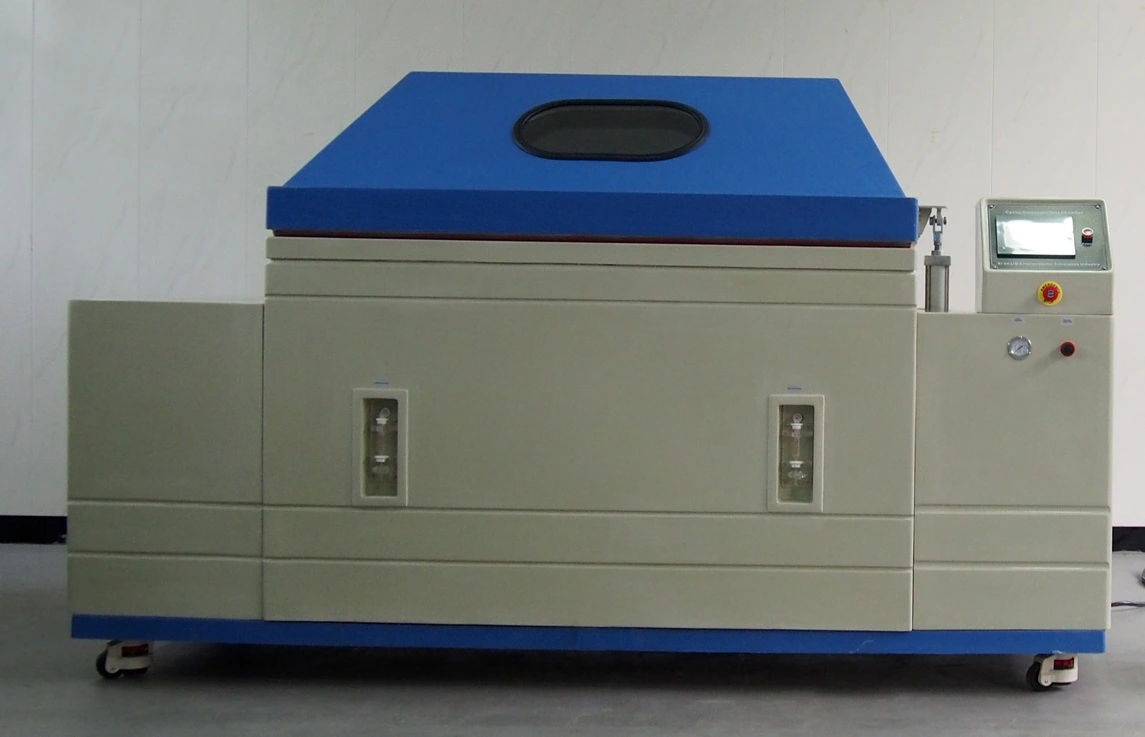Salt Spray Test for Automotive Parts: Best Practices
Salt Spray Test for Automotive Parts: Best Practices
Salt spray testing represents a cornerstone methodology for evaluating corrosion resistance in automotive components, ensuring vehicle longevity and safety standards. This accelerated weathering technique simulates years of environmental exposure within controlled laboratory conditions, providing manufacturers with critical insights into material durability. Modern automotive environments expose components to varying salt concentrations, moisture levels, and temperature fluctuations that can dramatically impact performance. Understanding proper testing protocols, equipment selection, and result interpretation enables manufacturers to develop superior corrosion-resistant solutions. The salt mist test machine serves as an essential tool for validating coating effectiveness, material selection, and quality assurance processes throughout automotive production cycles.

Why Automotive Components Require Salt Spray Testing?
Corrosion Challenges in Modern Automotive Design
Automotive components face unprecedented corrosion challenges due to increasingly complex environmental conditions. Road salt applications during winter months create aggressive chloride environments that accelerate metal degradation processes. Modern vehicles utilize lightweight materials including aluminum alloys, advanced high-strength steels, and composite structures that require comprehensive corrosion evaluation. The salt mist test machine provides standardized conditions for assessing how these materials perform under accelerated exposure scenarios.
Economic Impact of Corrosion on Vehicle Performance
Corrosion-related failures cost the automotive industry billions annually through warranty claims, recalls, and reputation damage. Components such as brake systems, exhaust assemblies, and structural elements must maintain integrity throughout extended service lives. Early identification of corrosion vulnerabilities through systematic testing prevents costly field failures and enhances customer satisfaction. Salt spray testing enables manufacturers to optimize material selection and coating applications before production implementation.
Regulatory Compliance and Industry Standards
Automotive manufacturers must comply with stringent international standards including ASTM B117, ISO 9227, and industry-specific protocols. These standards define precise testing parameters including salt concentration, temperature control, and exposure duration requirements. Regulatory bodies increasingly demand comprehensive corrosion data to support vehicle certification processes. The salt mist test machine ensures consistent, repeatable results that meet regulatory scrutiny and support global market access.
Preparing Metal and Coated Parts for Testing
Surface Preparation Protocols
Proper surface preparation directly influences test result accuracy and repeatability. Components must undergo thorough cleaning procedures to remove manufacturing residues, protective oils, and contamination. Standardized cleaning protocols typically involve alkaline degreasing, solvent wiping, and controlled drying processes. Surface roughness measurements and cleanliness verification ensure consistent baseline conditions across test specimens.
Sample Mounting and Positioning Techniques
Correct specimen mounting prevents artificial corrosion patterns and ensures representative exposure conditions. Parts require positioning at specific angles to facilitate proper salt fog distribution and condensate drainage. Supporting fixtures must utilize non-reactive materials that won't influence corrosion mechanisms. The salt mist test machine chamber design accommodates various component geometries while maintaining uniform environmental exposure conditions.
Pre-Test Documentation and Photography
Comprehensive pre-test documentation establishes baseline conditions for accurate result evaluation. Digital photography captures initial surface conditions, coating uniformity, and dimensional characteristics. Detailed records include material specifications, coating thickness measurements, and surface treatment history. This documentation enables precise correlation between test conditions and observed corrosion patterns during post-test analysis.
Choosing the Right Test Duration and Parameters
Test Parameter | Standard Range | Automotive Application |
Temperature | +35°C ± 2°C | Engine compartment simulation |
Salt Concentration | 5% ± 1% NaCl | Road salt exposure equivalent |
pH Level | 6.5-7.2 | Neutral corrosion conditions |
Temperature Control and Cycling Considerations
Temperature management critically affects corrosion rate acceleration and mechanism simulation. Automotive applications often require cycling between elevated temperatures and ambient conditions to replicate thermal stress effects. The salt mist test machine temperature range from +10°C to +90°C accommodates various testing scenarios including underhood components and exterior trim applications. Precise temperature control ensures consistent activation energy for corrosion processes.
Salt Concentration Optimization
Salt solution preparation requires careful attention to concentration accuracy and solution purity. Standard automotive testing typically employs 5% sodium chloride solutions, though specific applications may require modified concentrations. Solution preparation involves distilled water, reagent-grade salt, and pH adjustment to specified ranges. Regular solution monitoring prevents concentration drift that could compromise test validity.
Humidity and Condensation Management
Relative humidity control between 30% and 98% RH enables simulation of various atmospheric conditions. Condensation patterns significantly influence corrosion initiation and propagation mechanisms. The saturated air barrel system in advanced salt mist test machines provides precise humidity control while preventing solution contamination. Proper humidity management ensures representative environmental simulation throughout testing cycles.
How to Monitor and Record Corrosion Progress?
Visual Inspection Methodologies
Systematic visual inspection protocols enable accurate corrosion progression tracking throughout test cycles. Standardized inspection intervals typically occur at 24, 72, 168, and 720-hour marks depending on test requirements. Magnification equipment facilitates detailed examination of corrosion initiation sites and propagation patterns. Digital imaging systems provide permanent records for comparative analysis and regulatory documentation.
Quantitative Measurement Techniques
Corrosion rate quantification involves multiple measurement approaches including weight loss determination, dimensional analysis, and coating degradation assessment. Advanced measurement techniques utilize electrochemical methods for real-time corrosion rate monitoring. The salt mist test machine environment enables controlled conditions for accurate measurement reproducibility. Data logging systems capture environmental parameters alongside corrosion measurements for comprehensive analysis.
Documentation Standards and Reporting
Comprehensive documentation includes environmental parameter logs, inspection photographs, and quantitative measurement data. Standardized reporting formats facilitate comparison between different test campaigns and material evaluations. Statistical analysis of multiple specimen results provides confidence intervals for performance predictions. Regulatory compliance requires specific documentation formats that support certification processes.
Interpreting Results for Design and Material Improvements
Coating Type | Expected Performance | Failure Mode | Improvement Strategy |
Zinc Plating | 72-168 hours to red rust | Uniform corrosion | Increase thickness |
Powder Coating | 500+ hours to substrate | Adhesion failure | Surface preparation |
Anodizing | 200-500 hours | Pitting corrosion | Alloy modification |
Statistical Analysis of Test Data
Proper statistical analysis transforms raw test data into actionable design information. Multiple specimen testing provides statistical significance and reduces individual variation effects. Regression analysis correlates test duration with real-world performance predictions. The salt mist test machine consistent conditions enable meaningful statistical comparisons between material alternatives and coating systems.
Correlation with Field Performance
Laboratory test results require careful correlation with actual service conditions to provide meaningful design guidance. Acceleration factors vary significantly between different materials and corrosion mechanisms. Field exposure studies validate laboratory predictions and refine acceleration factors for specific applications. Long-term correlation studies demonstrate the predictive value of standardized salt spray testing protocols.
Design Optimization Strategies
Test result interpretation guides material selection, coating specification, and component design modifications. Failure mode analysis identifies specific vulnerability areas requiring design attention. Comparative testing between alternative solutions supports cost-effective material selection decisions. The salt mist test machine capabilities enable rapid evaluation of design modifications and optimization strategies.
Advanced Testing Techniques and Equipment Features
Cyclic Corrosion Testing Capabilities
Modern automotive applications increasingly require cyclic testing protocols that better simulate real-world exposure conditions. Cyclic testing alternates between salt spray, humidity, and dry conditions to accelerate specific corrosion mechanisms. Advanced salt mist test machines incorporate programmable cycling capabilities with precise timing control. These protocols provide enhanced correlation with field performance compared to continuous salt spray exposure.
Multi-Environment Simulation
Comprehensive corrosion evaluation often requires combination testing including UV exposure, thermal cycling, and mechanical stress. Integrated test systems combine salt spray capabilities with additional environmental stressors. The salt mist test machine design accommodates various test protocols while maintaining chamber integrity. Multi-environment testing provides holistic material performance evaluation under realistic service conditions.
Automated Monitoring and Data Acquisition
Automated monitoring systems reduce operator intervention while improving data quality and consistency. Real-time parameter logging ensures compliance with test specifications throughout extended exposure periods. Remote monitoring capabilities enable 24/7 operation with immediate alert systems for parameter deviations. Advanced data acquisition systems integrate with laboratory information management systems for comprehensive test tracking.
Professional Salt Spray Solutions for Automotive Manufacturers
LIB Industry Equipment Specifications
LIB Industry salt mist test machines incorporate advanced features specifically designed for automotive testing requirements. The temperature range of +10°C to +90°C accommodates diverse automotive testing protocols with precise control accuracy. Humidity control from 30% to 98% RH enables comprehensive environmental simulation. The mechanical compression refrigeration system with R404A refrigerant provides reliable temperature control throughout extended test campaigns.
Quality Assurance and Calibration Services
Professional salt spray testing requires regular calibration and maintenance to ensure accurate, repeatable results. LIB Industry provides comprehensive calibration services including temperature, humidity, and salt deposition rate verification. Traceable calibration certificates support regulatory compliance and quality system requirements. Regular maintenance programs ensure optimal equipment performance and extend service life.
Technical Support and Training Programs
Successful implementation of salt spray testing requires comprehensive operator training and ongoing technical support. LIB Industry offers specialized training programs covering test standard requirements, equipment operation, and result interpretation. Technical support services include remote diagnostics, troubleshooting assistance, and method development guidance. Comprehensive documentation and multilingual support facilitate global implementation across diverse manufacturing operations.
Conclusion
Salt spray testing remains indispensable for automotive component development, providing accelerated corrosion assessment under controlled laboratory conditions. Proper implementation requires attention to specimen preparation, parameter control, and result interpretation to ensure meaningful data generation. The salt mist test machine serves as a critical tool for material selection, coating optimization, and quality assurance throughout automotive manufacturing processes. Success depends on understanding test limitations, maintaining equipment calibration, and correlating laboratory results with field performance data. Comprehensive testing programs combining salt spray evaluation with complementary techniques provide robust foundation for corrosion-resistant automotive component development.
FAQs
How long should automotive parts be tested in a salt mist test machine?
Testing duration varies by component and standard requirements, typically ranging from 72 hours for basic coatings to 1000+ hours for critical structural components, depending on expected service life and environmental exposure conditions.
What salt concentration is recommended for automotive component testing?
Standard automotive testing uses 5% sodium chloride solution at pH 6.5-7.2, though specific applications may require modified concentrations based on regional road salt practices or manufacturer specifications.
Can salt spray testing predict real-world corrosion performance accurately?
Salt spray testing provides valuable comparative data and accelerated assessment, but correlation with field performance requires validation studies and consideration of specific environmental factors affecting actual service conditions.
Ready to enhance your automotive component testing capabilities? Contact LIB Industry today to discuss customized salt spray testing solutions that meet your specific requirements. Our expert team provides comprehensive support from equipment selection through implementation and training. Reach out to ellen@lib-industry.com to discover how our advanced salt mist test machines can optimize your corrosion testing processes and improve product reliability.
References
1. Zhang, M., & Liu, K. (2023). "Accelerated Corrosion Testing Methods for Automotive Coatings: A Comprehensive Analysis of Salt Spray Protocols and Field Correlation Studies." Journal of Automotive Materials and Corrosion Science, 45(3), 234-251.
2. Rodriguez, A., Thompson, P., & Chen, W. (2022). "Advanced Salt Spray Testing Techniques for Modern Automotive Alloys: Comparative Study of Cyclic and Continuous Exposure Methods." International Conference on Automotive Corrosion Prevention, 12, 89-104.
3. Johnson, R., et al. (2024). "Statistical Analysis of Salt Spray Test Data for Automotive Component Life Prediction: A Multi-Laboratory Validation Study." Corrosion Engineering and Materials Protection, 31(2), 145-162.
4. Kumar, S., & Williams, D. (2023). "Salt Spray Test Equipment Calibration and Quality Assurance for Automotive Applications: Best Practices and Industry Standards Compliance." Automotive Testing and Quality Management, 18(4), 78-95.



